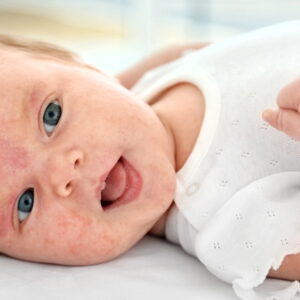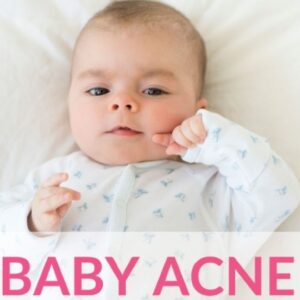Your newborn baby’s appearance is far from the sweet, perfect look you will see in any commercial, especially if born vaginally. To be honest, newborns do look a bit odd.
In this article, we sort out the reasons, from head to toe.
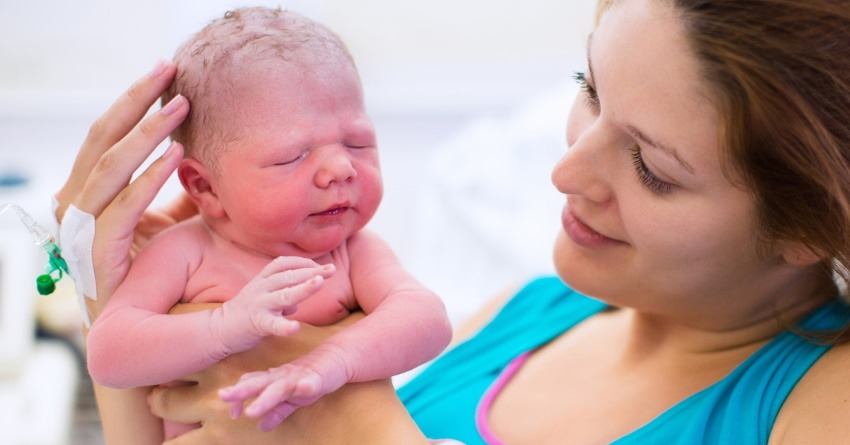
Below, we’ll walk you through the most common concerns regarding your newborn baby’s appearance. If you also want to learn about your newborn baby’s development, milestones, and how to stimulate your little baby, read this aticle.
Newborn Baby Appearance From Head To Toe
- A Molded Head
- Caput and Cephalohematoma
- Compressed Facial Features
- Newborn Skin Conditions
- Newborn Baby Hair
- Chest with Breast Lumps
- Pot Belly
- The Umbilical Cord Stump
- Cramped Arms and legs
- Swollen Genetalia
- What are newborn appearance red flags that I should keep an eye on?
Caput and Cephalohematoma
As your pelvic muscles push to get your baby through the birth canal, the amount of force can temporarily change your baby’s skull shape.
Some babies may develop a swollen area, usually in the middle of the head, within a few hours after birth. This is called caput succedaneum (or simply, caput). This usually happens when labor takes too long, or when either a forceps or vacuum cup are used to help delivery your baby.
On the other hand, a cephalohematoma is a buildup of blood that comes from small blood vessels that may have ruptured during a difficult delivery. It may look like a caput, but it is more tense and firm to touch. It’s found usually on one side of the skull only.
The blood in a cephalohematoma builds up on top of the skull bones, so it doesn’t put any additional pressure on the brain.
Caput usually goes away on its own after a few days, while a cephalohematoma may take several weeks to completely disappear.
Compressed Facial Features
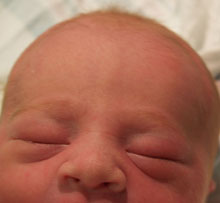
When studying the face of your newborn baby, you might be looking at a flattened ear, a squashed nose or even a crooked jaw. Not very pretty, but don’t worry, all of this is temporary.
Compressed facial features are a result of positioning in the uterus and are usually normal. Just make sure that your baby’s been examined by a doctor before leaving for home, to rule out any congenital anomalies.
Eyelid edemas, as shown in the picture, is common among newborn infants due to pressure on the face during the birth process. The edema should get better on its own after a few days.
Our youngest son, who was in a great hurry to enter the world, had such a large bruise over one of his eyes, that he couldn’t even open it during the first few days. Fortunately, the swelling got better on its own.
It may also be that you find your newborn’s eyes filled with ointment. Depending on where you live, the ointment is either an antibiotic called erythromycin or silver nitrate. In either case, the ointment is applied to prevent a type of pink eye called ophthalmia neonatorum (ON). This infection is usually caused by the sexually transmitted infection chlamydia, transmitted from the mom during birth. ON can actually cause blindness, which is why prevention with antibiotics or silver nitrate is part of the newborn care routine in many countries.
Newborn Skin Conditions
Right after your baby has been born, their skin may be covered by something called Vernix caseosa or vernix. This is a thick, sticky fluid which helps your baby adjust to the new environment outside your womb by maintaining the right body temperature and prevent unnecessary water loss from the body.
A newborn’s skin, which can be mottled or slightly blue due to a lower temperature in the environment, can be especially alarming to new parents. Mostly the mottling is because your baby’s nervous system is still developing. Increase the room temperature or add a layer of clothing to make your baby feel warm – the mottling usually goes away once your baby feels warm.
You might also see that your baby has some scratches or contusions, but like the rest, it will heal up in the first week or two.
Your newborn baby’s feet might look blue, because your baby’s blood circulation is not that effective yet towards the distant part of their arms and legs. Because of this, their feet might also be cold (especially since baby socks fall off all the time, as you will notice).
Many babies’ skin turn yellowish during their first days of life. This is due to some degree of newborn jaundice. While it’s a common condition, always let a pediatrician evaluate your baby, especially if your baby’s skin tone along their tummies and legs starts to become yellow.
In most cases, feeding the baby frequently and making sure the baby gets lots of daylight will be enough as both prevention and treatment for newborn jaundice. In some cases, the jaundice can become more severe and the baby will need supervision and treatment in the hospital. This includes treatment with phototherapy (“sunbathing” under blue lights) or blood exchange transfusion.
After a few weeks, it is normal for the baby to shed skin – the skin can become very dry, making many new parents worried. However, this is a period when the baby’s skin learns to adapt to the outer environment and the best thing you can do is to leave the skin alone. If you find some very dry spots, you can massage them gently with breast milk. If you feel uneasy with your baby’s dry skin, ask your doctor if you can use baby-friendly hypoallergenic lotion. Find more baby skin and hair care tips here.
Newborn baby skin can also be affected by several other conditions, of which the most common are:
- Baby Acne: A skin condition affecting around 20% of newborns during their second week of life. Usually, doing nothing is the best treatment and the acne will clear on its own.
- Diaper rash: Red irritated skin in the diaper area is something most babies will suffer from at some point. The most common causes are skin contact with moist, soiled diapers, and allergies with materials or dyes used in diapers.
- Cradle Cap: This affects 10% of all babies and usually disappears after babies turn 12 months old. Cradle cap is yellow and greasy scales you’ll most likely find on your baby’s skull, forehead, eyebrows or behind the ears. Special shampoos and moisturizing medications are used to treat cradle cap.
- Milia: These are small, white bumps on your newborn baby’s face, often on the nose, cheeks, and chin. Don’t try to get rid of them. These bumps are blocked sweat glands that usually resolve within a month or so without any treatment.
- Salmon patches and Stork bites: These are flat, reddish patches frequently found over the forehead and eyelids. Those seen at the nape of the neck are called “stork bites”. Salmon patches are benign overgrowths of small blood vessels near the skin that take months to years to disappear.
- Congenital dermal melanocytosis (formerly called Mongolian spots): These are flat, dark blue or grey patches seen at the back or buttocks, common in babies with dark skin. Like salmon patches, these are benign and go away after a few years on their own. In some cases, a few patches may not completely disappear.
- Erythema toxicum: Small yellowish bumps surrounded by reddish skin, much like acne, that appear along the cheeks, forehead, and the trunk is called erythema toxicum. There’s no clear reason yet why this develops, but without any medications, this skin condition becomes better after 1-2 weeks.
- Strawberry hemangioma: These are red, raised skin patches made up of blood vessels. These can grow bigger and look like the surface or texture of strawberries, hence the name. Strawberry hemangiomas should be seen by a doctor and monitored regularly.
- Port wine stain: Flat reddish-purple patches found anywhere in the body are most likely to be port wine stains. Like hemangiomas, these are caused by unusual growth of small blood vessels. Port wine stains may develop on their own, or as part of a genetic condition.
Newborn Baby Hair
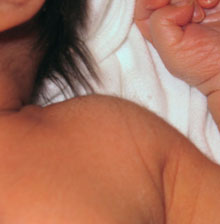
Some newborns come into the world with a fine coat of hair called lanugo covering their back, shoulders, and neck. While this hair is usually shed in the uterus, it can occasionally be seen on premature babies.
Don’t worry; your new baby is not a werewolf! The lanugo temporarily grows on your baby’s skin to help keep the vernix attached. It will usually shed within a few days if not a few hours.
Other babies have a lot of head hair that will either continue to grow or fall off. In any case most babies get a bald spot at the back of their heads when they’re a few months old due to tearing from lying down. Read about baby hair development here.
Chest with Breast Lumps
If you’ve noticed that your baby, male or female, has round lumps at the chest area that resemble breasts and may even lactate, this is most likely normal. This is called neonatal gynecomastia. It is just a result of being exposed to estrogen for an extended period of time in your womb. Gynecomastia will most likely go away without the need for any treatment.
Pot Belly
Don’t worry if it seems that your baby’s stomach are appears to be quite full, as though he or she has eaten something quite large. This slightly pot belly look is normal, especially after feedings. Just make sure that your baby’s tummy is soft and that they’re having regular bowel movements every day. Otherwise, it’s best to have your child checked by a doctor.
The Umbilical Cord Stump
The umbilical cord is how your baby receives oxygen and nutrients while inside your womb. This gets cut off right after your baby is delivered, but the blood vessels aren’t completely closed yet. It’s important that this umbilical cord stump dries up and falls off on its own, usually at the first two weeks of life. Don’t try to remove or manipulate the stump.
Find tips on how to care about the umbilical cord stump here.
Cramped Arms and legs
Some new parents are concerned about the fact that their baby’s limbs are cramped or a bit bowed. This is simply a result of being confined in the womb, as are their clenched fingers and toes. Usually, a doctor should be able to examine your baby’s arms and legs to rule out congenital hip dislocation. Before you know it, this stage will be a memory!
Also, some newborn baby’s arm movements can make you start wondering if something is wrong with your baby. The arms may flay out without control and may even start shaking, almost as if the baby has a mild seizure. This is called jitteriness. My midwife called it the “newborn movements” and told me they disappear quickly. They did, especially the shaking. (Read about shaking in slightly older babies here.)
Most jitters are normal, but some babies might need to be tested to rule out low blood sugar levels in the body (hypoglycemia). If your baby seems disturbed by his flaying arms you can try swaddling them and observe them for any new symptoms.
Swollen Genetalia
Some babies have enlarged or swollen genitals when they are born. For girls, this may be because of the high levels of estrogen that they have been exposed to. This is the same reason for babies having false menstruation during their first few weeks, which the doctors will tell you is perfectly normal and will resolve after 4 days.
Baby boys can also display some scrotal enlargement, which is usually due to a build-up of fluids. This tends to go down for 6 to 12 months, so if it’s still present after your child turns 1 year old, you might want to check it up with a doctor.
What are newborn appearance red flags that I should keep an eye on?
Now, you might wonder if there are newborn baby appearance red flags to look for. Yes, here are some important ones:
- Difficulty waking up, or very weak-looking
- Difficulty breathing
- Bluish discoloration (cyanosis) over the face or lips
- Fever
- Undescended testicle/s
- Swelling over the scalp area (caput or cephalhematoma)
That was about it! As I’m sure you understand now, if you got this far, newborn baby appearance is NOT all cute… They are small miracles, for sure, but pretty… nah! But… within weeks, they are much prettier!
More About Your Newborn Baby
- All post tagged Newborn
- Newborn Infant Milestones, Developmental Games And Toy Tips
- How To Bond With A Newborn Baby A Dad’s Guide
- Tips On Newborn Activities
- How Often Should A Newborn Pee?
Research References
- Caput Succedaneum
- Cephalohematoma
- Central and Peripheral Cyanosis
- Chapter 113 The Newborn Infant, Nelson Textbook of Pediatrics 21st ed 2020
- Erythema Toxicum
- Gynecomastia in Infants, Children, and Adolescents
So how about your baby? What did he or she look like? I’d love to hear all about your newborn baby’s appearance!

Paula Dennholt founded Easy Baby Life in 2006 and has been a passionate parenting and pregnancy writer since then. Her parenting approach and writing are based on studies in cognitive-behavioral models and therapy for children and her experience as a mother and stepmother. Life as a parent has convinced her of how crucial it is to put relationships before rules. She strongly believes in positive parenting and a science-based approach.
Paula cooperates with a team of pediatricians who assist in reviewing and writing articles.



